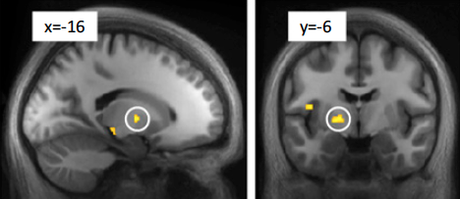Impress your friends that you know the name of a brain region that they haven't heard of before! Lawson et al., in yet another publication that includes Raymond Dolan as one its authors, find that the habenula encodes the dynamically changing negative motivational value of stimuli that predict primary punishments. One suggestion is that an overactive habenula might cause the feelings of impending doom and low motivation common in people with depression.

Learning what to approach, and what to avoid, involves assigning value to environmental cues that predict positive and negative events. Studies in animals indicate that the lateral habenula encodes the previously learned negative motivational value of stimuli. However, involvement of the habenula in dynamic trial-by-trial aversive learning has not been assessed, and the functional role of this structure in humans remains poorly characterized, in part, due to its small size. Using high-resolution functional neuroimaging and computational modeling of reinforcement learning, we demonstrate positive habenula responses to the dynamically changing values of cues signaling painful electric shocks, which predict behavioral suppression of responses to those cues across individuals. By contrast, negative habenula responses to monetary reward cue values predict behavioral invigoration. Our findings show that the habenula plays a key role in an online aversive learning system and in generating associated motivated behavior in humans.

